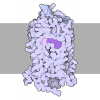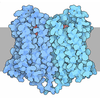+ Open data
Open data
- Basic information
Basic information
| Entry | Database: PDB / ID: 9m4t | ||||||
|---|---|---|---|---|---|---|---|
| Title | CryoEM structure of the alpha1AAR complex with silodosin | ||||||
 Components Components | Alpha-1A adrenergic receptor | ||||||
 Keywords Keywords | MEMBRANE PROTEIN / GPCR / Alpha1AAR / Silodosin | ||||||
| Function / homology |  Function and homology information Function and homology informationnegative regulation of heart rate involved in baroreceptor response to increased systemic arterial blood pressure / alpha1-adrenergic receptor activity / norepinephrine-epinephrine vasoconstriction involved in regulation of systemic arterial blood pressure / positive regulation of heart rate by epinephrine-norepinephrine / positive regulation of the force of heart contraction by epinephrine-norepinephrine / pilomotor reflex / phospholipase C-activating adrenergic receptor signaling pathway / neuron-glial cell signaling / cell growth involved in cardiac muscle cell development / positive regulation of action potential ...negative regulation of heart rate involved in baroreceptor response to increased systemic arterial blood pressure / alpha1-adrenergic receptor activity / norepinephrine-epinephrine vasoconstriction involved in regulation of systemic arterial blood pressure / positive regulation of heart rate by epinephrine-norepinephrine / positive regulation of the force of heart contraction by epinephrine-norepinephrine / pilomotor reflex / phospholipase C-activating adrenergic receptor signaling pathway / neuron-glial cell signaling / cell growth involved in cardiac muscle cell development / positive regulation of action potential / positive regulation of smooth muscle contraction / adult heart development / Adrenoceptors / positive regulation of cardiac muscle hypertrophy / positive regulation of vasoconstriction / smooth muscle contraction / response to hormone / adenylate cyclase-activating adrenergic receptor signaling pathway / positive regulation of cardiac muscle contraction / negative regulation of autophagy / positive regulation of synaptic transmission, GABAergic / caveola / cell-cell signaling / G alpha (12/13) signalling events / MAPK cascade / positive regulation of cytosolic calcium ion concentration / nuclear membrane / phospholipase C-activating G protein-coupled receptor signaling pathway / G alpha (q) signalling events / positive regulation of ERK1 and ERK2 cascade / positive regulation of MAPK cascade / intracellular signal transduction / G protein-coupled receptor signaling pathway / response to xenobiotic stimulus / protein heterodimerization activity / negative regulation of cell population proliferation / intracellular membrane-bounded organelle / apoptotic process / signal transduction / nucleoplasm / nucleus / plasma membrane / cytoplasm / cytosol Similarity search - Function | ||||||
| Biological species |  Homo sapiens (human) Homo sapiens (human) | ||||||
| Method | ELECTRON MICROSCOPY / single particle reconstruction / cryo EM / Resolution: 3.19 Å | ||||||
 Authors Authors | Liu, S.S. / Guo, Q. / Wang, D.D. / Tao, Y.Y. / Jiao, H.Z. | ||||||
| Funding support |  China, 1items China, 1items
| ||||||
 Citation Citation |  Journal: J Biol Chem / Year: 2025 Journal: J Biol Chem / Year: 2025Title: Molecular mechanism of antagonist recognition and regulation of the α-adrenoceptor. Authors: Sisi Liu / Haizhan Jiao / Yuyong Tao / Dandan Wang / Qiong Guo /  Abstract: The α-adrenoceptor (αAR) is a critically important class of G protein-coupled receptors, comprising 3 subtypes: αAR, αAR, and αAR. Currently, drugs targeting αAR have been used in the treatment ...The α-adrenoceptor (αAR) is a critically important class of G protein-coupled receptors, comprising 3 subtypes: αAR, αAR, and αAR. Currently, drugs targeting αAR have been used in the treatment of various diseases. Notably, antagonists of αAR play a pivotal role in the management of benign prostatic hyperplasia. In recent years, researchers have developed selective antagonists for the αAR subtype that have a minimal impact on blood pressure for the treatment of benign prostatic hyperplasia. However, these agents still exhibit certain side effects, necessitating the continuous development of new medications to mitigate adverse reactions while achieving more precise regulation. We report the cryo-EM structures of the αAR-selective antagonist doxazosin and the αAR subtype-selective antagonist silodosin in complex with αAR, demonstrating that M292 and V185 are key residues that confer subtype selectivity to silodosin. In addition, modifications to αAR enhanced silodosin's inhibitory efficacy against αAR. These findings deepen our understanding of the recognition patterns of αAR antagonists, revealing the molecular principles underlying the selective binding of silodosin to αAR and promoting further research and development of subtype-selective drugs targeting αAR. | ||||||
| History |
|
- Structure visualization
Structure visualization
| Structure viewer | Molecule:  Molmil Molmil Jmol/JSmol Jmol/JSmol |
|---|
- Downloads & links
Downloads & links
- Download
Download
| PDBx/mmCIF format |  9m4t.cif.gz 9m4t.cif.gz | 106 KB | Display |  PDBx/mmCIF format PDBx/mmCIF format |
|---|---|---|---|---|
| PDB format |  pdb9m4t.ent.gz pdb9m4t.ent.gz | Display |  PDB format PDB format | |
| PDBx/mmJSON format |  9m4t.json.gz 9m4t.json.gz | Tree view |  PDBx/mmJSON format PDBx/mmJSON format | |
| Others |  Other downloads Other downloads |
-Validation report
| Arichive directory |  https://data.pdbj.org/pub/pdb/validation_reports/m4/9m4t https://data.pdbj.org/pub/pdb/validation_reports/m4/9m4t ftp://data.pdbj.org/pub/pdb/validation_reports/m4/9m4t ftp://data.pdbj.org/pub/pdb/validation_reports/m4/9m4t | HTTPS FTP |
|---|
-Related structure data
| Related structure data |  63629MC  9m4qC M: map data used to model this data C: citing same article ( |
|---|---|
| Similar structure data | Similarity search - Function & homology  F&H Search F&H Search |
- Links
Links
- Assembly
Assembly
| Deposited unit | 
|
|---|---|
| 1 |
|
- Components
Components
| #1: Protein | Mass: 35792.500 Da / Num. of mol.: 1 Source method: isolated from a genetically manipulated source Source: (gene. exp.)  Homo sapiens (human) / Gene: ADRA1A, ADRA1C / Production host: Homo sapiens (human) / Gene: ADRA1A, ADRA1C / Production host:  Homo sapiens (human) / References: UniProt: P35348 Homo sapiens (human) / References: UniProt: P35348 |
|---|---|
| #2: Chemical | ChemComp-A1EMV / Mass: 495.534 Da / Num. of mol.: 1 / Source method: obtained synthetically / Formula: C25H32F3N3O4 |
| Has ligand of interest | N |
| Has protein modification | Y |
-Experimental details
-Experiment
| Experiment | Method: ELECTRON MICROSCOPY |
|---|---|
| EM experiment | Aggregation state: PARTICLE / 3D reconstruction method: single particle reconstruction |
- Sample preparation
Sample preparation
| Component | Name: CryoEM structure of the the alpha1AAR complex with silodosin Type: COMPLEX / Entity ID: #1 / Source: RECOMBINANT |
|---|---|
| Molecular weight | Experimental value: NO |
| Source (natural) | Organism:  Homo sapiens (human) Homo sapiens (human) |
| Source (recombinant) | Organism:  Homo sapiens (human) Homo sapiens (human) |
| Buffer solution | pH: 7.4 |
| Specimen | Embedding applied: NO / Shadowing applied: NO / Staining applied: NO / Vitrification applied: YES |
| Vitrification | Cryogen name: ETHANE |
- Electron microscopy imaging
Electron microscopy imaging
| Experimental equipment |  Model: Titan Krios / Image courtesy: FEI Company |
|---|---|
| Microscopy | Model: TFS KRIOS |
| Electron gun | Electron source:  FIELD EMISSION GUN / Accelerating voltage: 300 kV / Illumination mode: FLOOD BEAM FIELD EMISSION GUN / Accelerating voltage: 300 kV / Illumination mode: FLOOD BEAM |
| Electron lens | Mode: BRIGHT FIELD / Nominal defocus max: 2300 nm / Nominal defocus min: 1700 nm |
| Image recording | Electron dose: 50 e/Å2 / Film or detector model: GATAN K3 (6k x 4k) |
- Processing
Processing
| CTF correction | Type: NONE |
|---|---|
| 3D reconstruction | Resolution: 3.19 Å / Resolution method: FSC 0.143 CUT-OFF / Num. of particles: 3759439 / Symmetry type: POINT |
 Movie
Movie Controller
Controller




 PDBj
PDBj








